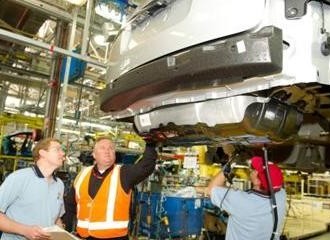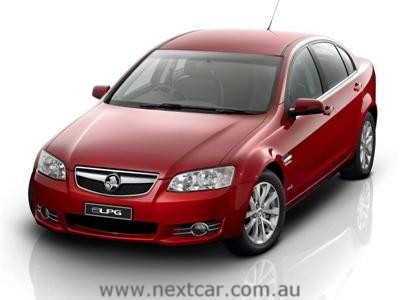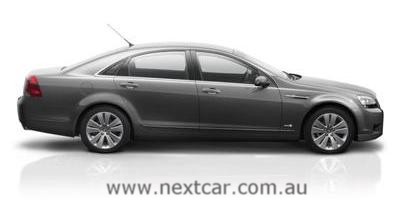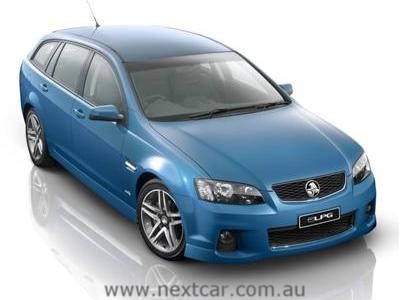Holden LPG models commence production
|
 Production of the dedicated LPG Commodore models
Production of the dedicated LPG Commodore models
commenced in Adelaide on 27th February 2012.
 Holden Berlina with dedicated LPG
Holden Berlina with dedicated LPG
 Holden Caprice with dedicated LPG
Holden Caprice with dedicated LPG
 Holden Commodore SV6 with dedicated LPG
Holden Commodore SV6 with dedicated LPG
The LPG option price is $2,500*. Private buyers of new
factory-fitted LPG vehicles can apply for a Federal Government rebate (currently $2,000).
|
|
|
Home >
News >
General Motors >
Holden
Recent new car releases ..... here
Upcoming new car releases ..... here
28th February, 2012
Production commenced yesterday on the new dedicated LPG Commodore at
Holden’s Vehicle Operations in Elizabeth, South Australia.
The new LPG system will be available in models across all Commodore variants encompassing Sedan, Sportwagon, Ute and
Caprice.
Plant Launch Operations Manager, Tony Sylvester said the introduction of the new LPG Commodore to the plant required a
number of operational and technical enhancements to be integrated into the build process to accommodate the new model and
technology.
“A number of changes across the site were made with the introduction of this model including unique body panels,
changes to the facia assemblies moulded in our Plastics operations and a completely new fuel system put into place in
General Assembly,” he said.
Where previously the LPG fitment of the dual fuel vehicles was completed off line, the introduction of the dedicated
LPG system now required the capability to fuel vehicles with LPG during the build process to enable the car to be driven
off the end of the production line.
Holden has taken an innovative approach to overcome the cost and complexity of adding an additional fuel line into the
plant. Holden Engineers have worked with the tank supplier to come up with the solution of providing pre-fuelled tanks
which are then installed as part of the build process on the Chassis Line.
“By having the LPG tanks pre-fuelled when supplied has eliminated the need to install an LPG fuel line in the plant
resulting in reduced costs for the programme, increased productivity and has ensured that the introduction of the new
model into the plant is smooth as possible,” Mr Sylvester said.
Launched in 2008, Holden’s Ecoline is about better fuel efficiencies today and next generation fuel advances for
tomorrow that are better for the environment and affordable for the typical family. Four years later, Holden’s philosophy
has not changed and the all-new dedicated LPG system perfectly epitomises the future-friendly strategy.
The dedicated LPG fuel system joins the line-up of Ecoline badged models currently produced at the Elizabeth plant
that includes E85 capability across all Commodore and Caprice models, Spark Ignition Direct Injection (SIDI) on V6
models, Active Fuel Management (AFM) on automatic V8 models and a 2.0-litre diesel offering for the Cruze sedan and
hatch.
“Whether it is performance, economy or size as the main driver for the customer’s purchase we have the flexibility
and skill at our South Australian facility to build a variety of combinations to meet their needs,” Mr Sylvester
said.
The introduction of the dedicated LPG Commodore is the latest model launch for Holden Vehicle Operations that in the
last 12 months has seen the launch of the locally-made Cruze sedan and hatch line-up, MY12 model year enhancements to the
Commodore and the introduction of the Chevrolet Police car programme.
The all-new dedicated LPG range will be available in Australian dealerships from next month.
Development
Holden’s dedicated LPG Commodore was the subject of an intensive and exhaustive engineering programme that ensures a
vehicle tailor-made for Australian conditions, with a raft of local engineering solutions that is intended to make this
the best LPG Commodore ever produced.
Holden’s Programme Engineering Manager for the LPG Commodore programme, Brian McMurray, says the scope and exacting
execution of this engineering programme has ensured customers are buying a vehicle that is world-class for driveability,
CO2 emissions and fuel running costs.
|
|
|

Self-Catering Holiday
Accommodation in
Denmark, WA
..... more
|
|
|
“The engineering team had three crucial targets for this programme. To achieve less than 200 grammes of CO2 per
kilometre across the range, to ensure fuel running costs comparable to a small or medium-sized petrol car and finally,
to ensure a seamless drive experience for customers familiar with a petrol Commodore,” said Mr Murray.
“I’m very proud to say that the team has achieved, or exceeded, those goals. After more than 1.3 million
development kilometres and 78 testing and evaluation prototypes, the Holden engineering team has executed a
no-compromise LPG experience.”
LPG injection system
At the very beginning of the LPG project, Holden engineers evaluated liquid and vapour-injection LPG systems. After
preliminary research and building a proof of concept liquid injection prototype vehicle, it quickly became apparent
that vapour injection was the only solution to achieving the programme’s goals.
“Vapour injection provides lower fuel consumption and lower CO2 emissions compared to liquid, while vapour also
uses fuel more efficiently with fewer pumping and parasitic losses,” said Mr McMurray.
“Vapour systems are less mechanically demanding and therefore better suited to the varying grades of LPG fuel found
across Australia.”
“Vapour is also best suited to the Australian climate, with more consistent start-up in hot climatic
conditions.”
Powertrain
The 'heart' of the LPG Commodore is the 3.6-litre, double overhead cam V6 engine, with four valves per cylinder. This
engine has been designed to run solely on LPG and therefore has allowed for design optimisation in several key areas.
The entire LPG fuel system has seen significant development, with new fuel injectors, fuel rail and LPG fuel filter.
Specific fuel injectors have been developed, with these injectors target positioned within the engine to optimise fuel
delivery – giving better performance, lower CO2 emissions and improved driveability and durability.
The fuel control system has also been optimised in the areas of fuelling, spark advance and cam positioning to ensure
that the advantages of LPG are fully realised for lowest possible CO2 emissions and best performance and driveability
under Australian driving conditions.
Additional highlights include hardened valves and valve seats to ensure long-term durability, while the heads and
manifold are also designed specifically for the LPG Commodore to ensure optimised air flow and combustion.
As LPG contains a higher octane rating than petrol, new pistons of an optimised design have been used to raise the
compression ratio to 12.2:1 to take full advantage of LPG fuel.
A particular highlight of the dedicated LPG Commodore is the new six-speed automatic transmission. Lighter, smarter
and more refined, this new transmission boasts sophisticated control software that optimises shift patterns to provide
outstanding driveability.
The end result is a world-class engine with excellent performance and outstanding fuel economy. Producing 180 kW of
power and 320 Nm of torque, the dedicated LPG engine eclipses the outgoing dual-fuel LPG variant by 5 kW and 2 Nm. And
yet the new LPG Commodore Omega sedan records 11.8 L/100 km on the ADR combined cycle, an improvement of 1.6 L/100 km –
or 13 per cent – compared to the dual-fuel LPG Omega sedan.
Additional highlights
Over the duration of the exhaustive LPG Commodore engineering project, numerous local engineering solutions were
implemented by Holden engineers and suppliers. Several of these engineering innovations have been awarded patents.
Additional engineering highlights include the purpose-designed LPG vapouriser. This unit regulates the flow of liquid
LPG, subsequently heating the fuel and causing it to vapourise, making the vapour that is then injected into the
combustion chamber. The vapouriser is another made-to-measure component, and is the only one of its type being used by an
OEM manufacturer anywhere in the world on an engine of this capacity.
In order to use the vapouriser, Holden engineers had to make and execute new software to operate the vapouriser and
integrate it into the powertrain system. This required unique code to be written for both the ECM and VCM management
systems.
Spent exhaust gasses are managed through a specifically-designed exhaust system which is differentiated from the rest
of the range by a single exhaust outlet, which also aids with refueling in hot climate conditions. This newly designed
exhaust uses a twin-muffler system positioned mid-vehicle and is tailored to refinement, power and torque requirements
for the LPG engine.
Refinement has also been paid special attention, with a specifically tailored noise and vibration package to ensure a
pleasurable drive.
Safety
Safety was an overriding priority throughout the LPG Commodore programme. Like all VE Commodores, the LPG model goes
beyond the mandated Australian regulatory requirements and scores the maximum five-star ANCAP safety rating while
providing outstanding real-world safety.
With its rigid body structure with multiple load paths for maximum energy absorption in an impact, ESP standard on all
models, as well as six standard airbags in every model, the Commodore remains one of the safest popular cars on the road
today.
But the LPG programme provided its own unique challenges to the safety engineering team.
The tank
LPG requires a larger tank than petrol in order to achieve a similar range, so to keep mass contained, Holden’s safety
engineers developed a lightweight, 84-litre aluminium tank – which Holden believe is the only mass-produced,
OEM-equipped, aluminium fuel tank anywhere in the world.
In order to balance mass and weight distribution with our stringent safety requirements, the safety team relocated the
tank rearward of the rear axle which was an intense engineering exercise in itself and required significant re-routing of
the exhaust system among other modifications.
The tank itself is constructed from high-strength, multi-celled, aircraft grade extruded aluminium with
strategically-placed additional aluminium protection plates.
The aluminium tank was the subject of intense research and development activity, including numerous simulated and
physical tests of both the tank itself and in-situ within the vehicle in the form of nine barrier crash tests performed
in-house.
Model choice
The LPG Commodore range mirrors the recently upgraded MY12 petrol Commodore line-up for features and specifications,
offering the same value story which has kept VE Commodore a favourite with customers since launch.
Additionally, Holden will launch an LPG Commodore Equipe sedan and Sportwagon. Offering outstanding value, the Equipe
adds a number of desirable features on top of the Omega specification, including:
- 18-inch alloy wheels
- Rear view camera
- Rear park assist
- Leather appointed seat trim
- Leather wrap steering wheel
- Front fog lamps with chrome accents
NOTE: * Manufacturer's List Price (MLP) excludes dealer delivery fees and the numerous statutory
charges (commonly known as on-road costs). Additionally, please note that all prices, fees and charges are
subject to change without notice, as are the specifications.
|